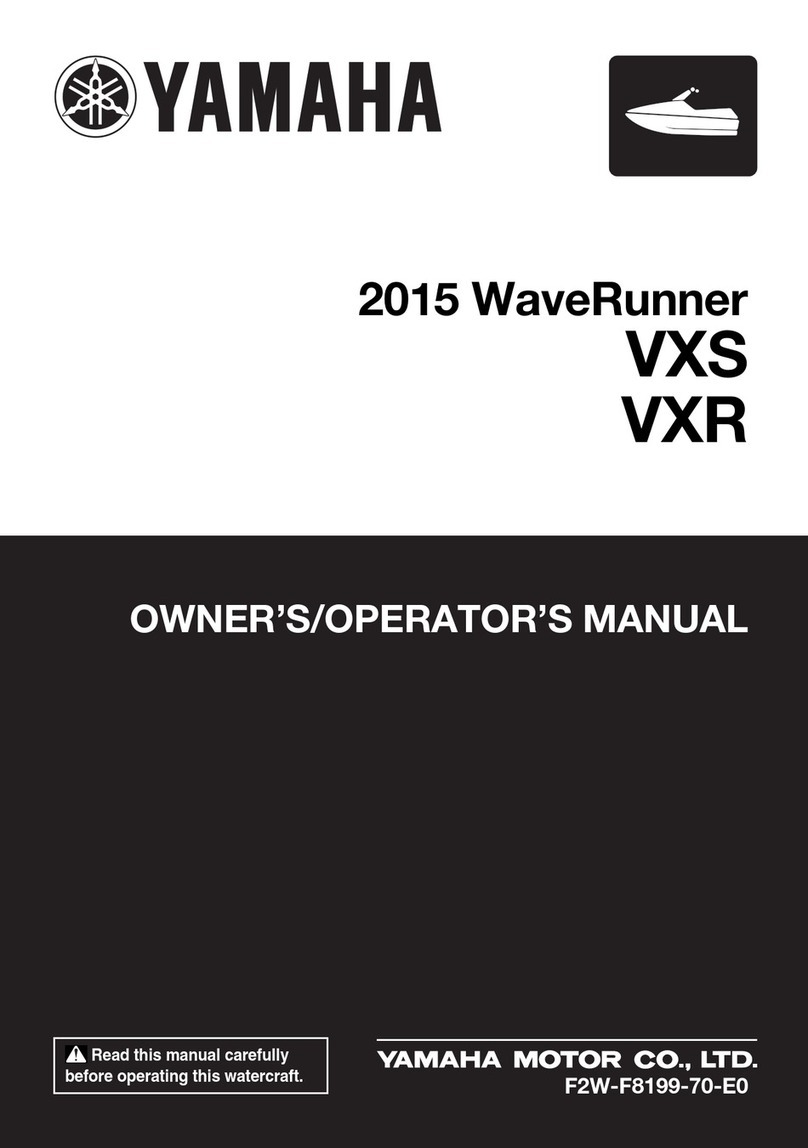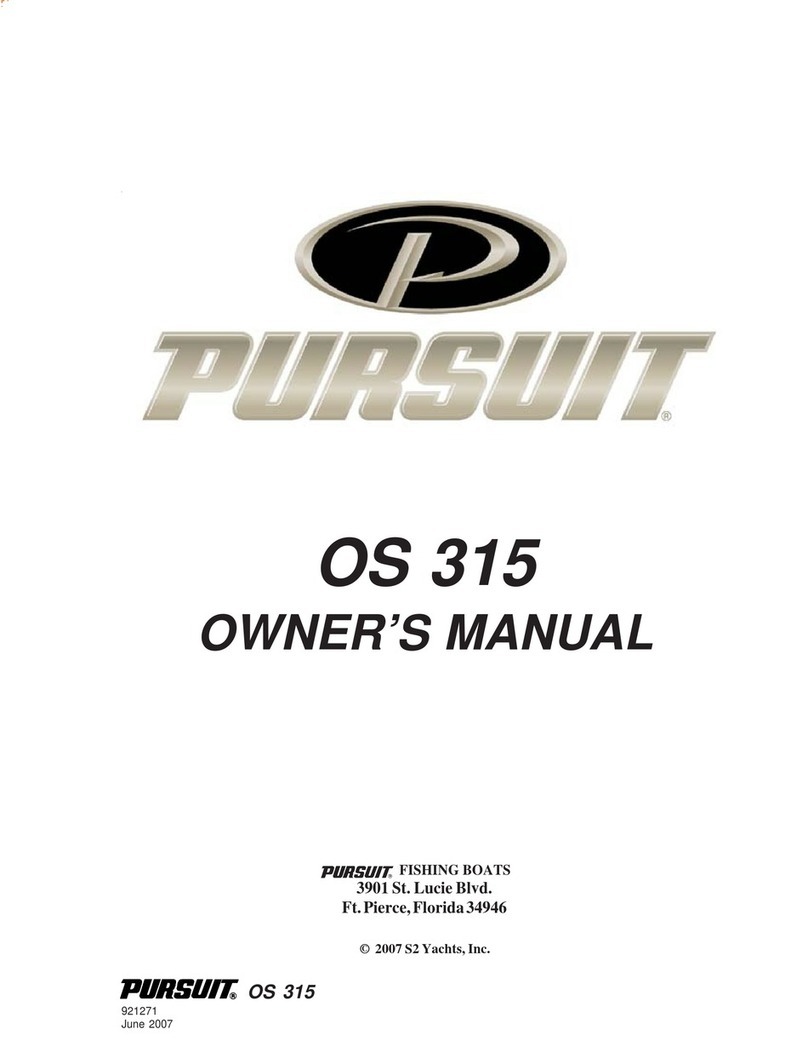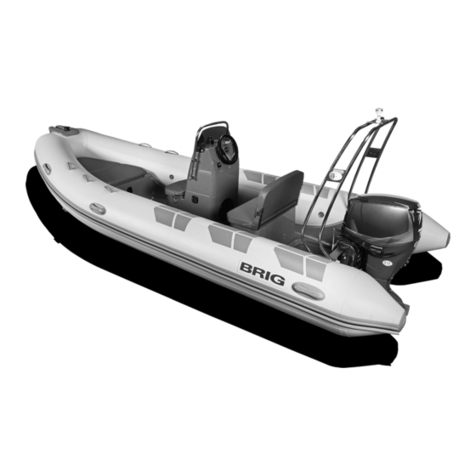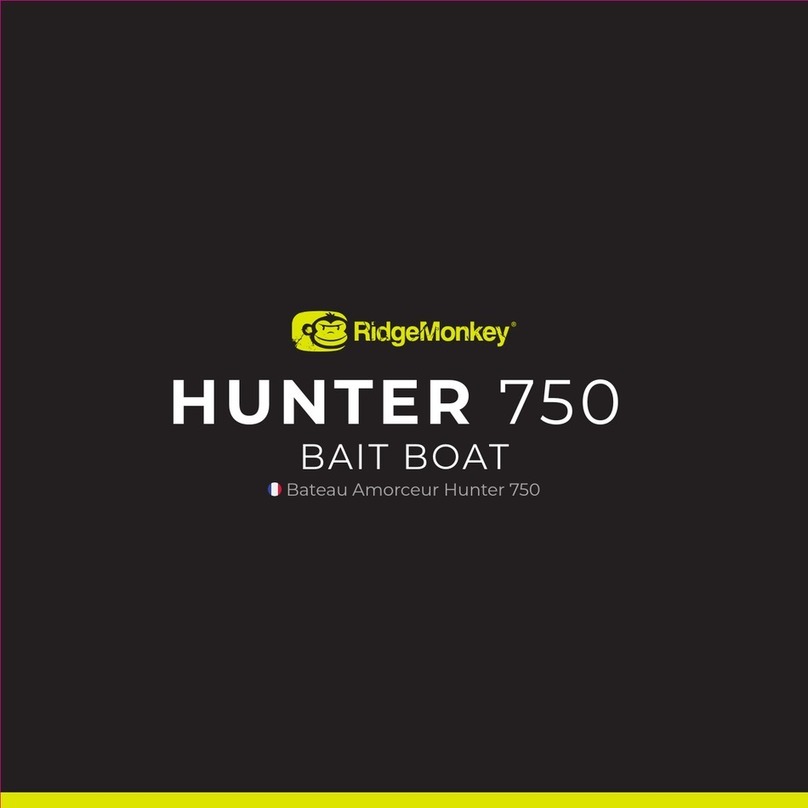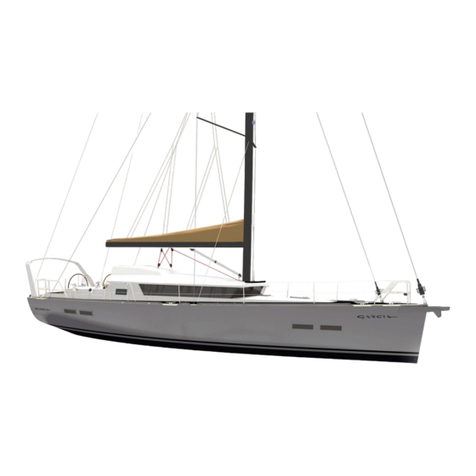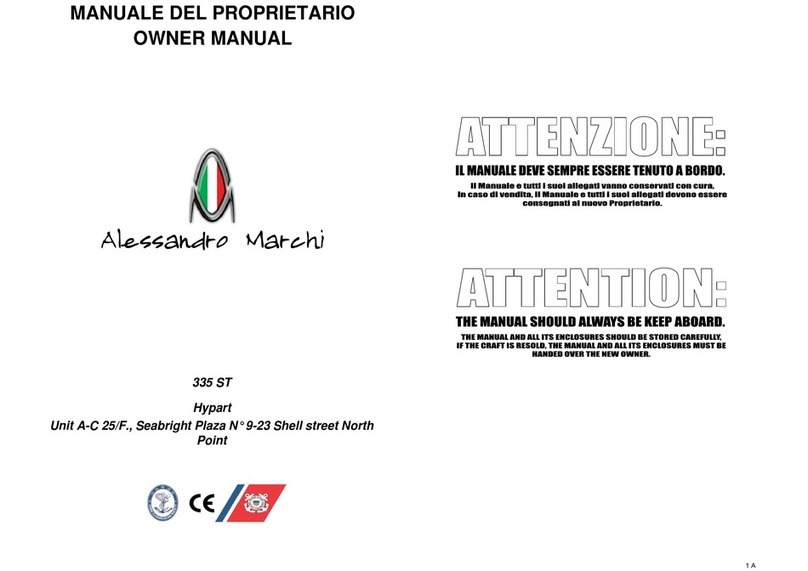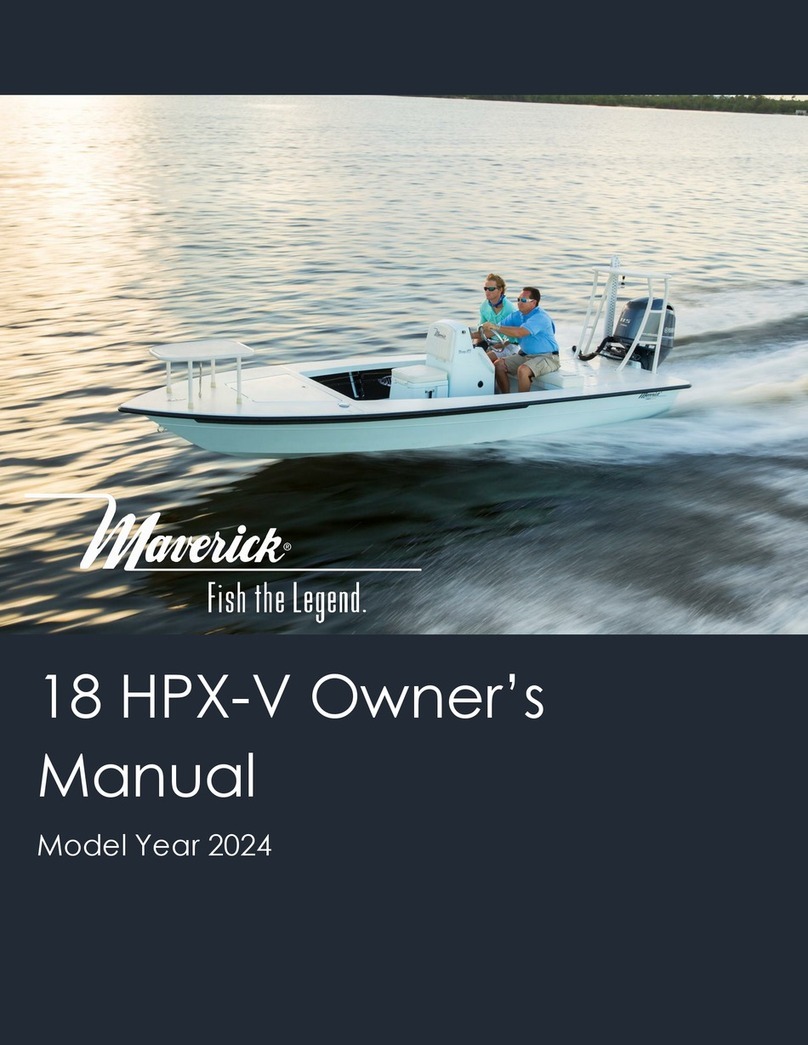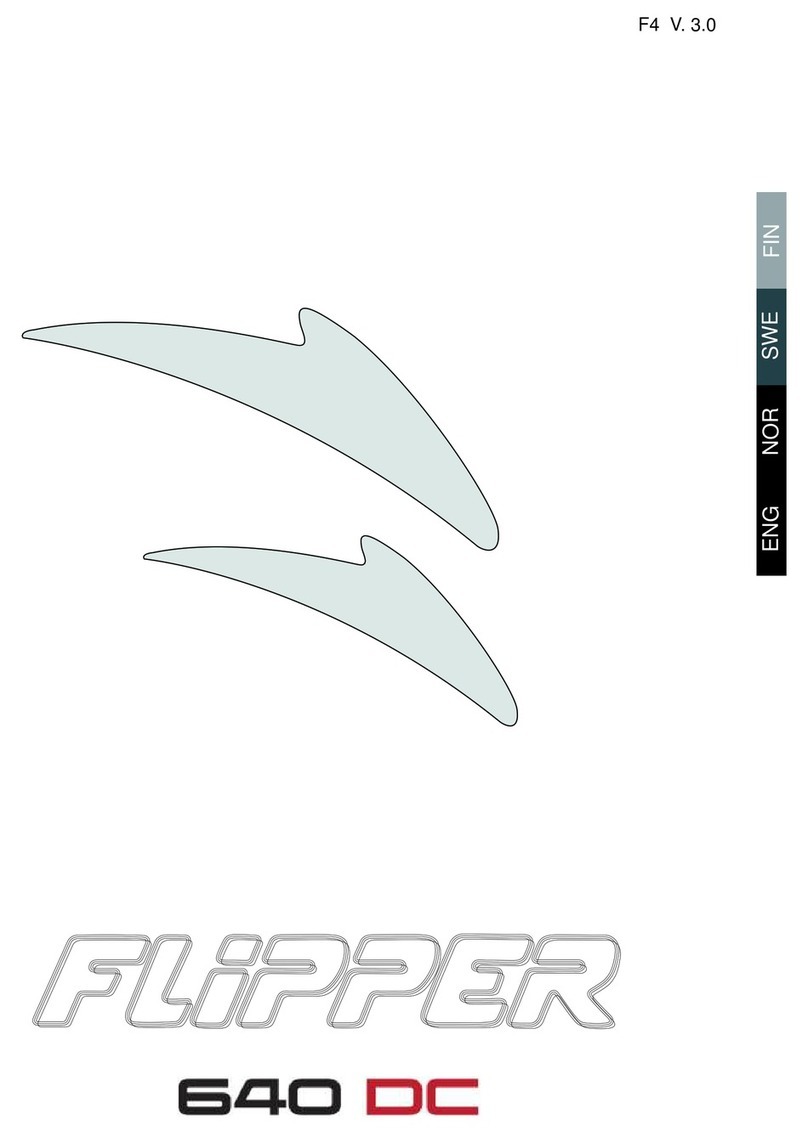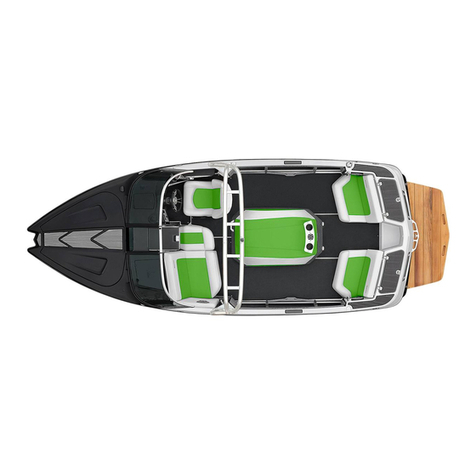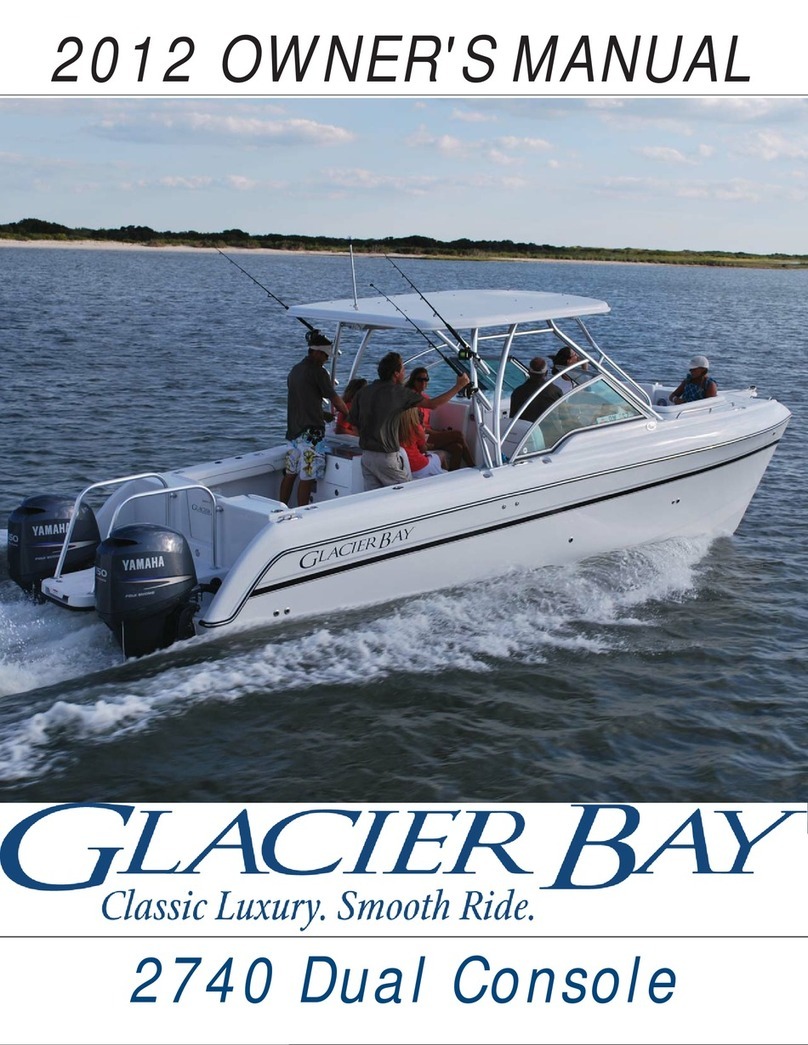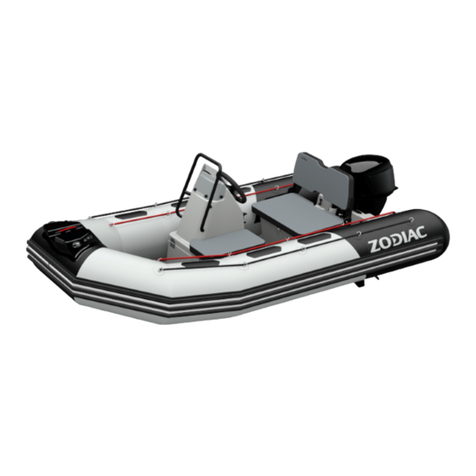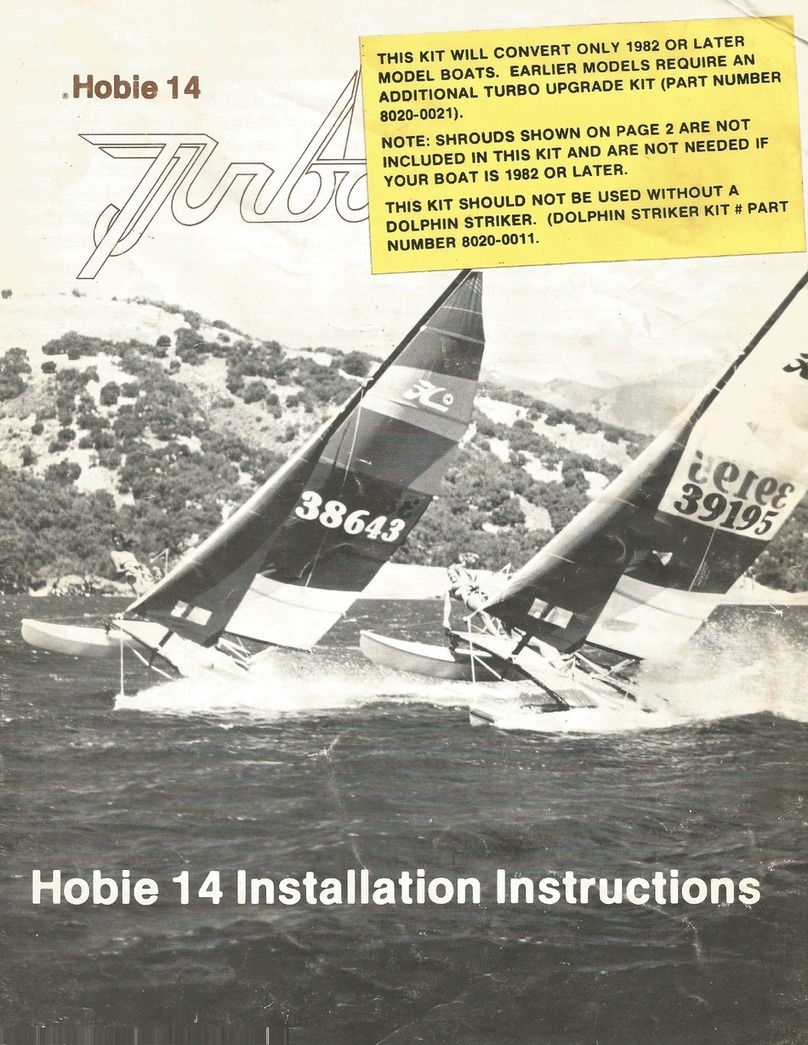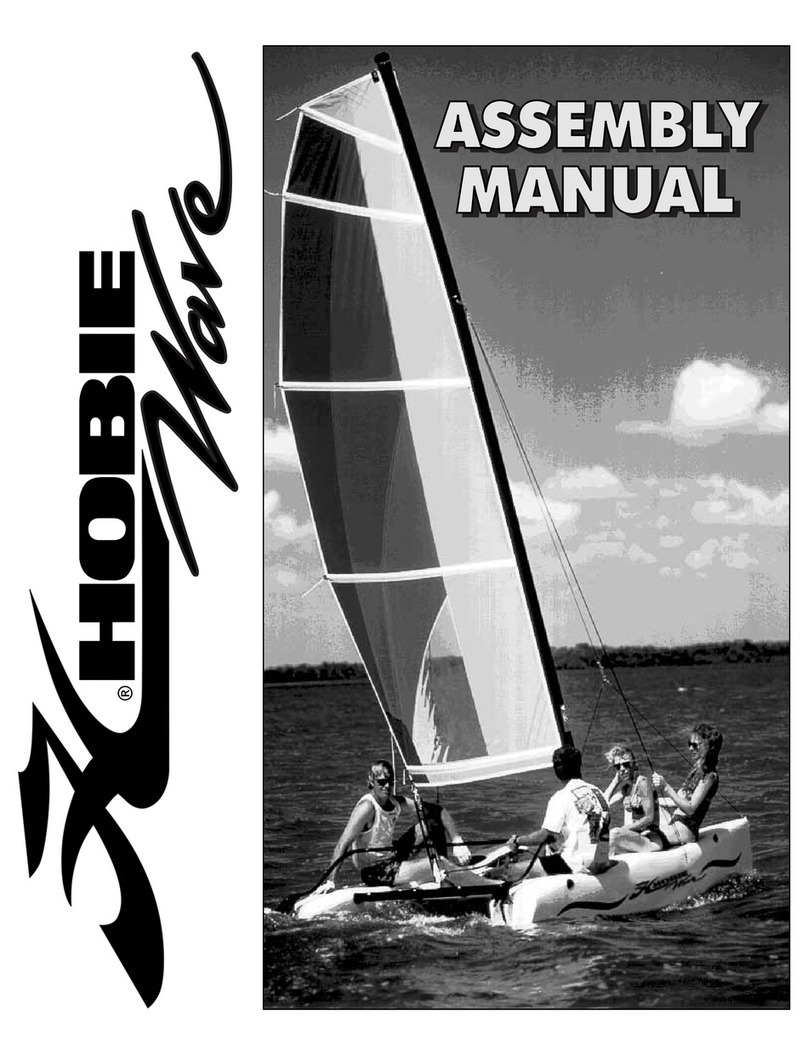GEKKO GTS 20 2015 User manual

Owner’s Manual 2015

Congratulations on becoming a part of the Gekko team! Since it’s inception in 1994,
Gekko has been consistently blessed with rave reviews, proven at the world champi-
onship level and captured a global following. !
This owner’s manual is designed to as an important reference and as a familiariza-
tion tool to for you become more knowledgeable about your Gekko boat, boat opera-
tion, safe boating practices, boating rules and regulations, maintenance, and other
important aspects regarding the use of your boat.
Before hauling or operating your new boat, it is crucial that you understand informa-
tion in this manual. Your authorized Gekko dealer is a valuable source of information
about your boat and necessary requirements for a safe and fun water sports experi-
ence. If you have any questions or concerns after reading this manual contact your
dealer.
The latest product information available at the time of publication provided the basis
for all data, pictures, information and specifications featured in this manual. Informa-
tion about numerous Gekko models is presented. As standard and optional equip-
ment varies from model to model, some information contained in this manual may
not apply to your boat. This manual is not all-inclusive. There are many factors to
consider and additional training and information that is necessary to research and
participate in before undertaking any boating activity.
At its sole discretion, Gekko Boats reserves the right to change model line specifica-
tions, designs, equipment, color schemes at any times without notice and without in-
curring obligation.
By giving you this information we hope to ensure that your new Gekko will be a
source of exceptional water sports fun for years to come.
ii

iii
Ch. 2: Hazardous Boating Conditions.......................................... 15-17
!!Weather................................................................................ 16
""Severe Weather................................................................... 16
""Reduced Visibility................................................................. 16
""Cold Water and Weather Conditions.................................... 16
""Water Hazards..................................................................... 16
""Aquatic Vegetation............................................................... 17
""Shallow Water...................................................................... 17
""Dams and Spillways............................................................. 17
""Restricted Areas................................................................... 17
""Markers, Warnings and Advisories....................................... 17
Ch. 3: Emergencies......................................................................... 18-22
!!Emergencies........................................................................ 19
""First Aid/Medical Emergencies............................................. 19
""Emergency Preparation Checklist........................................ 19
""Carbon Monoxide Poisoning................................................ 19
""Fire and Explosion............................................................... 19
""Using Distress Signal Devices and Calling for Help............. 20
""Capsizing and Flooding........................................................ 20
""Man Overboard.................................................................... 20
""Running Aground................................................................. 21
""Dangerous Weather............................................................. 21
""Engine or Boat System Failure............................................ 21
""Accidents, Collisions and Giving Assistance........................ 21
""Towing on the Water............................................................. 21
Ch. 4: Boating Regulations............................................................ 23-26
!!Boating Regulations............................................................. 24
""Boater Responsibility............................................................ 24
""Law Enforcement................................................................. 24
""Registration, Numbering and Documentation...................... 24
""Insurance............................................................................. 24
""Giving Assistance................................................................. 24
""Reporting Accidents............................................................. 25
Table Of Contents
Ch. 1: Safety................................................................................... 1-14
!!Safety Alert Symbols.......................................................... 1
""Safety Precautions............................................................. 2
""Safety Guidelines............................................................... 3
""Common Sense Advisory................................................... 4
""Operator’s Responsibilities................................................. 4
""Safety Decals and Notices................................................. 4
""Carbon Monoxide (CO)...................................................... 6
""Sources of CO Poisoning................................................... 6
""Weight Limits and Distribution............................................ 7
""Safety Equipment............................................................... 7
""USCG Required Safety Equipment.................................... 8
""Personal Flotation Devices (PDF’s)................................... 9
""Fire Extinguisher................................................................ 9
""Visual Distress Signals (VDS’s)......................................... 9
""Audible Distress Signals.................................................... 10
""Emergency Stop Switch and Lanyard................................ 10
""Navigational Lights............................................................. 11
""Fire..................................................................................... 11
""Capsizing........................................................................... 11
""Running Aground or Striking Underwater Objects............. 11
""Water Sports Safety........................................................... 12
""Water Sports Hand Signals................................................ 13
""Water Sports Accessories.................................................. 13
""“Teak” or “Platform Dragging”............................................ 13

iv
""Boating Under the Influence................................................... 25
""Operator’s License................................................................. 25
""Speeding and Noise............................................................... 25
""Wake...................................................................................... 25 "
""Protecting the Environment.................................................... 25
""Foreign Species Transportation............................................. 25
""Pollution................................................................................. 26
Ch. 5: Navigational Rules................................................................ 27-31
!!Navigational Rules................................................................. 28
""Right-of-Way.......................................................................... 28
""The General Prudential Rule................................................. 28
""Navigational Lights................................................................ 28
""Encountering Other Vessels.................................................. 28
""Meeting.................................................................................. 28
""Crossing................................................................................ 29
""Overtaking............................................................................. 29
""Navigational Situations.......................................................... 30
""Navigational Markings........................................................... 30
Ch. 6: Model Guide......................................................................... 32-36
!!GTS 20.................................................................................. 33
""GTR 22.................................................................................. 34
""REVO 6.7.............................................................................. 35
""REVO 7.1.............................................................................. 36
Ch. 7: Boat Features & Options...................................................... 37-
!!Boat Features and Options.................................................... 38
""Steering System..................................................................... 38
""Propeller................................................................................. 38
""Shift and Throttle Controls..................................................... 39
""Gauges and Instruments........................................................ 39
""Speed Control System........................................................... 40
""Fuel Level/Voltage/Engine Temp/Oil Pressure Multi Gauge... 40
""Tachometer............................................................................ 41
""Speedometer.......................................................................... 41
""Speedometer Paddle Wheel............................................... 41
""Control Switches.................................................................. 42
""Ignition Switch..................................................................... 42
""Blower Switch...................................................................... 42
""Bilge Pump Switch.............................................................. 42
""Courtesy Lights Switch........................................................ 42
""Lights Switch....................................................................... 42
""Horn Switch......................................................................... 42
""Circuit Breakers................................................................... 42
""12 Volt Receptacle.............................................................. 43
""Ballast System..................................................................... 43
""Batteries.............................................................................. 43
""Voltage Sensitive Relay....................................................... 43
""Stereo.................................................................................. 44
""Mirror................................................................................... 44
""Pylon................................................................................... 44
""Tower................................................................................... 44
""Board Rack.......................................................................... 45
""Swim Platform..................................................................... 45
""Rear Tow Eye...................................................................... 45
""Motor Box............................................................................ 45
""Heater System..................................................................... 46
""Fuel System........................................................................ 46
""Engine Cooling System....................................................... 46
""Engine Exhaust System...................................................... 46
""Engine Lubrication System.................................................. 47
""Electrical System................................................................. 47
""Drain Plug............................................................................ 47
Ch. 8: Operation............................................................................. 48-53
""Preparation Before Boating................................................. 49
""Fueling................................................................................. 49
""Safety Checks..................................................................... 49
""Before Operation................................................................. 49
""During Operation.................................................................. 50
""After Operation..................................................................... 50

v
""Breaking in Your New Boat.................................................... 50
""Boarding................................................................................. 50
""Loading the Boat.................................................................... 50
""Starting and Operation........................................................... 51
""Starting the Engine................................................................ 51
""Shifting Gears........................................................................ 51
""Underway............................................................................... 51
""Basic Maneuvering................................................................ 52
""Stopping................................................................................. 52
""Docking and Tie-Up............................................................... 52
""Anchors and Anchoring.......................................................... 53
""Emergencies.......................................................................... 53
""Courtesy................................................................................. 53
""Operating Conditions............................................................. 53
Ch. 9: Maintenance & Care............................................................... 54-62
!!General Maintenance and Care............................................. 55
""New Boat Break-In Maintenance........................................... 55
""Before Each Use.................................................................... 55
""Inspect Battery Connections.................................................. 55
""Inspect Throttle and Shift Cables........................................... 56
""Inspect Fuel System.............................................................. 56
""Note Any Exhaust Odors........................................................ 57
""Inspect Seacock Strainer....................................................... 57
""Check that the Battery is Fully Charged................................ 57
""Check for Water Leaks and Tighten/Install All Drain Plugs.... 57
""After Each Use....................................................................... 57
""Cleaning................................................................................. 58
""Marine Growth....................................................................... 58
""Hull......................................................................................... 58
""Corrosion Protection.............................................................. 58
""Salt Water Corrosion.............................................................. 58
""Carpet..................................................................................... 59
""Seadeck Flooring and Platforms............................................ 59
""Windshield.............................................................................. 59
""Boat Covers............................................................................ 59
""Upholstery............................................................................ 59
""Recommended Cleaning Products...................................... 60
""Non-Recommended Cleaning Products.............................. 60
""Quarterly Maintenance (Every 50 Hours)............................ 60
""Annual Maintenance (Every 100 Hours).............................. 60
""Inspect the Fuel System and Replace Fuel Filter................ 61
""Check Propeller Shaft Coupler Alignment........................... 61
""Lubricate Steering System................................................... 61
""Lubricate Throttle and Shift Cables...................................... 61
""Check Engine Mounts.......................................................... 62
""Check Ballast Pump Impeller(s).......................................... 62
""Fire Extinguisher Unit.......................................................... 62
""Indmar Engine Maintenance Schedule................................ 62
Ch. 10: Winterization & Storage.................................................... 63-67
""Winterization and Storage................................................... 64
""General Preparation............................................................ 64
""Fuel System Treatment........................................................ 64
""General Power Preparation................................................. 65
""Winterization Preparation.................................................... 65
""Ballast System Preparation................................................. 65
""Re-Activating the Boat After Storage................................... 66
""Propeller Maintenance......................................................... 66
""Storing on a Cradle or Blocks.............................................. 66
""Storing on a Trailer............................................................... 66
""Lifting................................................................................... 67
Ch.11: Trailering & Launching....................................................... 68-76
""Gekko Trailers...................................................................... 69
""Trailer Type.......................................................................... 69
""Trailer Gross Vehicle Weight Rating.................................... 69
""Weight Distribution............................................................... 70
""Vehicle Towing Hitch............................................................ 70
!!Hitch Ball and Trailer Coupler.............................................. 70
""Safety Chains/Cables.......................................................... 71
""Breakaway Cable................................................................ 71

vi
""Trailer Winch Assembly......................................................... 71
""Swing Tongue........................................................................ 71
""Towing Vehicle....................................................................... 72
""7-Pin Wiring Connector.......................................................... 72
""How to Attach the Trailer........................................................ 72
""Trailer Lights.......................................................................... 73
""Wheels................................................................................... 73
""Tires....................................................................................... 73
""Trailer Brakes........................................................................ 74
""Trailer Jack............................................................................ 74
""Trailering Guidelines.............................................................. 74
""Backing Up............................................................................ 75
""Launching.............................................................................. 75
Ch. 12: Warranty............................................................................... 77-80
!!Limited Lifetime Warranty....................................................... 78
""What Warranty Covers........................................................... 78
""What Warranty Does Not Cover............................................. 78
""Warranty Service................................................................... 80
""Gekko Boats Website............................................................ 80
""
""
""
""
""
""
""
""
""
""
"

1
Safety

Safety Alert Symbols
iThis is the safety alert symbol.
It is used to alert you to potential personal injury hazards. Read and
abide by all messages following the safety alert symbol to avoid
possible injury or death.
DANGER indicates a hazardous situation which, if not avoided, will
result in death or serious injury.
WARNING indicates a hazardous situation which, if not avoided, could
result in death or serious injury.
CAUTION indicates a hazardous situation which, if not avoided, could
result in minor or moderate injury.
2
Safety Precautions
Complying with the safety recommendations found in this Owner’s Manual is critical
to keeping your boating experience as safe as possible during routine operation. Fail-
ure to do so may result in severe injury or death to you and/or others. Use caution
and common sense when operating your boat. Do not take unnecessary chances!
The safety precautions listed in this manual and on the boat are not all-inclusive, nor
do they address the myriad of potentially dangerous and life threatening scenarios
that exist. Make sure that all boat operators and passengers are aware of all safety
concerns and operations information. Further, you must be confident that your deci-
sion to use any equipment, parts or tools, perform procedures, practices or methods
that are not specifically recommended by Gekko Boats will not damage your boat, is
safe and does not endanger you or others.
As a boat owner, you are responsible for your own safety, as well as that of your pas-
sengers and other boaters. Boating-related accidents are often times caused by the
boat operator’s failure to follow basic safety rules or written precautions. The major-
ity of accidents can be avoided if the operator is completely familiar with the boat, its
operation and can recognize potentially hazardous situations before an accident oc-
curs.
iDANGER
Failure to observe safety recommendations may result in severe per-
sonal injury or death to you and/or others. Always use caution and com-
mon sense when operating your boat or participating in any boat related
activities, including periods of time when the boat engine is shut down
and the boat is not in operation.
Recognizing potentially dangerous situations is the first step to avoiding boating-
related accidents. Following basic safety instructions and precautions can reduce
boating-related accidents. In addition to the information in this manual be aware of
other specific safety guidelines not listed. Gekko Boats recommends all boat opera-
iDANGER
iWARNING
iCAUTION

3
tors to pursue additional training from a recognized boating and/or safety organiza-
tion prior to the operation of any boat.
The following agencies and organizations offer additional safety training and/or in-
formation:"""" "
American Red Cross, National HQ
8111 Gatehouse Road, 6th Floor
Falls Church, VA 22042"
(202) 737-8300
www.redcross.org
U.S.A. Water Ski Association
1251 Holy Cow Road"
Polk City, FL 33868"
(863) 324-4341
www.usawaterski.org
Boat Owners Association of the United States
880 South Pickett Street
Alexandria,VA 22304
(703) 823-9550
www.boatus.com
National Safe Boating Council
2550 M Street NW, Suite 425
Washington, DC 20037"
(202) 296-4588
www.safeboatingcouncil.org
U.S. Coast Guard Auxiliary
2100 Second Street SW
Washington, DC 20593-001
(202) 267-1001
www.uscg.mil http://www.uscgboating.org
Safety Guidelines
Improper operation of any boat is extremely dangerous! Operators must read and
understand all operating manuals supplied with the boat, before operation. In addi-
tion to specific safety statements noted in this manual, a general list of safety
guidelines and recommendations is listed below:
•On-boat equipment must always conform to the governing federal, state
and local regulations.
•Before each outing, check all safety equipment such as fire extinguishers,
life jackets, flares, distress flags, flashlights and engine stop switch. They
should be operable, in good condition, readily visible and easily accessed.
•Never allow any type of spark or open flame on-board. It may result in fire
or explosion.
iDANGER
Never override or modify components of the emergency safety or fuel
systems in any way.
•All persons must be seated in a designated occupant seating area while
the boat is in motion.
•Passengers should never sit in front of the operator; always avoid obstruct-
ing the operator’s view.
•Never stand or allow passengers to stand or sit on the motor box or tower,
gunwhale, decks or any location other than occupant seating while under-
way. You and/or others may be thrown within or from the boat, which
could result in serious injury or death.
iDANGER
Gasoline vapors can explode! Before starting the engine, you must
open the engine box and check the engine compartment and bilge for
gasoline and oil vapors. You must operate the blower for at least 4

4
minutes. Failure to do so may result in serious injury or death to you
and/or others.
•Never operate the boat or engage in any water activities while under the
influence of alcohol or drugs.
•Children and nonswimmers should wear a life jacket at all times.
•Never leave children in the boat without adult supervision.
•Never swim near the boat when the engine is running. Even if the boat is
in the NEUTRAL position, the propeller may still be turning and carbon
monoxide may be present.
•Watch for other boats, swimmers and obstructions in the water. Stay
away from other boats and personal watercraft.
Common Sense Advisory
Gekko Boats cannot anticipate every scenario or neglect that could result in dam-
age to the boat or that may cause illness, injury or even death to boaters. The op-
erator, owner and/or all persons on board are responsible for using common sense
and careful thought process to ensure that every measure is taken to keep boating
enjoyable. A Gekko boat should be the source of exceptional water sports fun for
years to come, but the boating experience remains safe only if YOU, and everyone
on board, uses common sense before, during and after boating activity.
Operator’s Responsibilities
•Always ensure that the boat is in top operating condition and there are no
hazards that could interfere with the operation of the boat.
•Check that the bilge is clean before starting the engine.
•Have complete knowledge of the operations system or your boat.
•Do not exceed the maximum capacity for your boat and ensure that all
weight is evenly distributed throughout the seating areas.
•Have familiarity with the layout of the waterways around you and your des-
tination.
•Know and practice navigational rules and obey all federal and state regula-
tions.
•Maintain a safe speed and keep an eye out for other boaters at all times.
Safety Decals and Notices
In compliance with the Unites States Coast Guard Regulations, Gekko Boats meet
or exceed all safety standards designed for recreational boats. To ensure safe
handling and performance, each Gekko boat displays various hazard and safety
decals which are affixed at the time of manufacture. These decals are applied in
specific locations on the boat and boat equipment where safety is of concern. All
decals must remain legible at all times. If a decal is removed or damaged contact
your dealer for immediate replacement.

5
•GASOLINE VAPORS CAN EXPLODE. BEFORE STARTING ENGINE:
-OPERATE BLOWER for 4 minutes
-CHECK THE ENGINE COMPARTMENT for gasoline vapors by sight and smell.
•OPERATE BLOWER to clear gasoline vapors from engine compartment when
engine is at idle, while below cruising speed and after stopping engines.
•CARBON MONOXIDE (CO) CAN CAUSE BRAIN DAMAGE OR DEATH.
-Engine exhaust contains odorless and colorless carbon monoxide gas.
-Signs of carbon monoxide poisoning include nausea, headache, dizziness,
drowsiness, and lack of consciousness.
-MOVE TO FRESH AIR if anyone shows signs of carbon monoxide poisoning.
-SEE OWNER’S MANUAL for additional information regarding carbon monoxide
poisoning.
•CHECK WEATHER FORECAST BEFORE DEPARTING DOCK and heed all
weather advisories.
•WEAR SAFETY LANYARD at all times while operating boat to prevent unmanned
boat operation.
•NEVER OPERATE WHILE UNDER THE INFLUENCE of drugs or alcohol.
•DO NOT OVERLOAD THE BOAT. ENSURE THAT WEIGHT IS PROPERLY AND
EVENLY DISTRIBUTED fore and aft and on both sides of the boat to avoid poor
handling, sudden loss of control, swamping and/or capsizing.
•USCG APPROVED LIFE JACKETS SHALL BE ON BOARD FOR ALL
PASSENGERS AND TOWED PARTICIPANTS.
•MAKE SURE THAT ALL PASSENGERS ARE PROPERLY SEATED WHILE
UNDERWAY. To avoid passengers falling overboard or being ejected from the boat,
do not allow passengers to sit on seat backs, gunwales or outermost deck edges
while the boat is moving.
•REDUCE SPEED BEFORE ATTEMPTING SUDDEN OR SHARP TURNS, AND
MAINTAIN SAFE SPEEDS for water conditions and environment at all times.
Maneuverability at high speeds is limited, and sudden turns may cause loss of boat
control.
•KEEP PROPER LOOKOUT AND SAFE DISTANCE for the conditions at all times to
avoid collisions.
•OBEY APPLICABLE NAVIGATION RULES AND BOATING LAWS.
•USE CAUTION AND PROPER LIGHTING during nighttime boating and boating in
adverse weather.
•READ THE OWNER’S MANUAL AND COMPLETE THE BOATER’S PRE-
OPERATION CHECKLIST PRIOR TO BOAT OPERATION.
Failure to follow these warnings could cause severe injury or death
i
WARNING

6
Carbon Monoxide (CO)
Carbon Monoxide (CO) is a colorless, tasteless, odorless and poisonous gas pro-
duced by all engines and fuel burning appliances. Even with the best boat design
and construction, plus the utmost care in inspection, operation and maintenance, haz-
ardous levels of CO may still be present under certain conditions. To reduce CO ac-
cumulation, always ventilate the boat interior and avoid boating situations which
cause increased exposure.
iDANGER
Direct and prolonged exposure to CO will cause brain damage and/or
death. Signs of exposure to CO include irritated eyes, headache, nau-
sea, dizziness, and drowsiness.
Carbon Monoxide poisoning should not be confused with seasickness, intoxication or
heat stress. If a passenger is experiencing irritated eyes, headache, nausea, weak-
ness, dizziness or drowsiness, or you suspect carbon monoxide poisoning, immedi-
ately move the person to fresh air, investigate the cause, and take corrective action.
Seek medical care if necessary.
Carbon Monoxide from exhaust pipes of inboard or outboard engines can build up
inside and outside of the boat in areas near the exhaust vents, especially during
slow-speed operation. To reduce the risk of CO inhalation stay clear of the exhaust
vent areas and do not swim or engage in water activities near the exhaust vent areas
while the boat is in operation.

7
Sources of CO Poisoning Weight Limits and Distribution
The Unites States Coast Guard requires all boats to have weight limits. Every boat
has a different weight limit or maximum capacity due to the different build of each
boat. A decal posted in each boat will determine the maximum capacity allowed for
that particular model.
iWARNING
Failure to adhere to the posted maximum capacities can cause operation
instability and/or the boat to sink. This may result in serious injury of
death, as well as significant damage to the boat.
Keep in mind that maximum weight limits include any additional equipment such as
water ballast bags and the water put in them, any additions to the original boat build
and all people. The maximum number of people is limited to the number of desig-
nated passenger seating positions.
The distribution of weight is equally as important. Weight should be evenly distrib-
uted throughout the boat. Too much weight in one area can greatly impact the opera-
tors ability to maintain control of the boat. Anytime weight is shifted or added to the
boat the handling characteristics of the boat may change. Be cautious when putting
the boat into motion or when attempting to stop it, especially when the weight charac-
teristics have changed.
Safety Equipment
Federal law requires certain safety equipment to be on-board your boat at all times.
There are also additional items that Gekko Boats recommends boaters to carry in
case of an emergency. It is the boaters responsibility to check with the local boating
authorities for any additional requirements and/or equipment over and above the fed-
eral requirements.
Blockage of boat exhausts by
obstruction.
Operating at slow speed or while dead
in the water.
Operating with high bow angle.
Exhausts from other vessels in confined
areas.
Operating with canvas tops and side
curtains in place without ventilation.
Desired airflow through the boat.

8
USCG Required Safety Equipment
Gekko Boats recommends the following additional safety equipment:
•Anchor with at least 75 feet (23 m) of line.
•Manual bailing device for removing water.
•Combination oar/boat hook
•Cell phone
•Compass
•Mooring lines and fenders
•Electrical tape and wire
•Emergency Position Indicating Radio Beacon (EPIRB)
•First aid kit and manual
•Waterproof flashlight
•Non-electric horn or whistle
•Set of local navigational charts
•Portable, battery-operated AM/FM radio or weather scanner
•Extra batteries for flashlight and radio
•Extra engine oil
Less than 16
ft (4.8 m)
Class 1: 16
to 26 ft (4.7
7.9m)
Class 2: 26
to 40 ft (7.9
to 12.2 m)
Class 3: 40
to 65 ft (12.2
to 19.8 m)
Personal
flotation
devices
(PFDs)
One Coast
Guard
approved
Type I, II, III
or V wearable
PFD for each
person on-
board.
One Coast Guard approved Type I, II, III or V
wearable PFD for each person on-board and
one throwable Type IV PFD device.
One Coast Guard approved Type I, II, III or V
wearable PFD for each person on-board and
one throwable Type IV PFD device.
One Coast Guard approved Type I, II, III or V
wearable PFD for each person on-board and
one throwable Type IV PFD device.
Fire
Extinguisher
s
One Coast Guard approved
B-I type.
One Coast Guard approved
B-I type.
One Coast
Guard
approved B-
II.
One Coast
Guard
approved B-
II AND B-I
OR three B-I
type.
Visual
distress
signaling
devices
One electric
distress light
or three day
and night
combination
red flares.
One orange distress flag or one electric
distress light OR three floating or handheld
orange smoke signals and one electric
distress light OR three day and night
combination red flares, handheld, parachute
or meteor type.
One orange distress flag or one electric
distress light OR three floating or handheld
orange smoke signals and one electric
distress light OR three day and night
combination red flares, handheld, parachute
or meteor type.
One orange distress flag or one electric
distress light OR three floating or handheld
orange smoke signals and one electric
distress light OR three day and night
combination red flares, handheld, parachute
or meteor type.
Less than 16
ft (4.8 m)
Class 1: 16 to
26 ft (4.7
7.9m)
Class 2: 26 to
40 ft (7.9 to
12.2 m)
Class 3: 40 to
65 ft (12.2 to
19.8 m)
Audible
distress
signaling
devices
A vessel less than 39.4 ft (12
m) must have on-board one
efficient sound-producing
device. (Example: hand or
mouth whistle OR a
compressed or powered air
horn.)
A vessel less than 39.4 ft (12
m) must have on-board one
efficient sound-producing
device. (Example: hand or
mouth whistle OR a
compressed or powered air
horn.)
If the vessel is less than 39.4 ft
(12m) it must have one efficient
sound-producing device.
(Example: hand or mouth
whistle OR a compressed or
powered air horn.) If the vessel
is greater than 39.4 ft (12m) but
less than 65.6 ft (20 m) in
length it must carry a power
whistle or powered air horn
AND a bell.
If the vessel is less than 39.4 ft
(12m) it must have one efficient
sound-producing device.
(Example: hand or mouth
whistle OR a compressed or
powered air horn.) If the vessel
is greater than 39.4 ft (12m) but
less than 65.6 ft (20 m) in
length it must carry a power
whistle or powered air horn
AND a bell.
Navigation
Lights
Regulations require that navigational lights be clearly lit and
properly displayed at all times between sunset and sunrise and
always when operating in reduced visibility while boating.
Regulations require that navigational lights be clearly lit and
properly displayed at all times between sunset and sunrise and
always when operating in reduced visibility while boating.
Regulations require that navigational lights be clearly lit and
properly displayed at all times between sunset and sunrise and
always when operating in reduced visibility while boating.
Regulations require that navigational lights be clearly lit and
properly displayed at all times between sunset and sunrise and
always when operating in reduced visibility while boating.

9
•Extra fuses
•Visual distress signals
•Electrical wire
•Tool kit
•Tow line
•Tool kit
•Emergency food and water
Personal Flotation Devices (PFDs)
Federal law requires that at least one wearable USCG-approved Type I, II, III or Type
V Personal Flotation Devices (PFD) is readily accessible for each person on-board or
being towed behind the boat on any type of recreational or water sports equipment.
In addition each boat must have one USCG-approved Type IV throwable PFD on-
board.
PFDs should be stored in an easily accessible place and all passengers should know
the location of the PFDs and how to wear and adjust them. Children and non-
swimmers should wear PFDs at all times.
Take note that requirements for coastal waters and inland waters differ, as well as
requirements from state to state. Check with the local boating authorities for more
information on the requirements for your area.
Choosing the proper PFD type and size is very important to your safety as well as
your passengers safety while boating. There are four types of wearable PFDs and
one type used only for throwing in emergency situations. PDF sizes generally corre-
spond to chest size and weight. It is important to make sure that you are choosing
the correct size for you and your passengers. All PDFs are labelled with the weight
range for that particular style and size.
Fire Extinguisher
All Class I, II, and III boats are required to carry a USCG-approved fire extinguisher.
For marine use in boats all fire extinguishers must be classified to extinguish type B
fires which are gasoline, oil, or grease fires. The size and number of extinguishers
vary based on the size of the boat. The two most common type B fire extinguishers
are B-I and B-II. Each type is classified by the extinguishing compound amount used
within.
Store all handheld fire extinguishers in readily accessible areas away from the en-
gine compartment and other combustible devices. All passengers should know the
location and the operating procedure of each extinguisher. Check the extinguishers
condition and pressure gauge regularly to ensure that it is in good operating condi-
tion. If the extinguisher is damaged or not properly pressurized, replace it immedi-
ately. Follow the fire extinguishers manufacturer’s instructions for proper use and
operation of the fire extinguisher.
Visual Distress Signals (VDS)
All vessels must be equipped with USCG -approved visual distress signals when trav-
eling on coastal waters, great lakes, territorial seas and those waters connected di-
rectly to them up to a point where a body of water is greater than two miles wide.
Vessels that are owned in the United States that are traveling on the high seas must
also be equipped with USCG -approved visual distress signals.

10
There are several different visual distress signals that can be used. Types of visual
distress signals vary by emergency situation. Visual distress signals are classified as
either pyrotechnic or non-pyrotechnic.
Pyrotechnic visual distress signals must be USCG - approved, in serviceable condi-
tion, and readily accessible. USCG - approved visual distress signals include pyro-
technic red flare, hand-held or aerial; pyrotechnic orange smoke, hand-held or float-
ing, or launchers for aerial red meteors or parachute flares. Pyrotechnic visual dis-
tress signals must be within the clearly marked expiration date stamp on the device.
Some pyrotechnics may be restricted on certain bodies of water. Check with the lo-
cal authorities, or visit the National Association of State Boating Law Administrators
(http://www.nasbla.org) or the United States Coast Guard (http://uscg.org) for addi-
tional information.
Non-pyrotechnic devices may also be an option. Non-pyrotechnic devices include an
orange distress flag (day signal only) or an electric distress light (night use). Use of
these devices must still meet the USCG requirements.
Each distress signal has its advantages. No single device is suitable for all situations
or conditions. Check with the local authorities regarding the best visual distress sig-
nal for use in the area in which you will be boating.
Audible Distress Signals
All vessels are required to be equipped with audible distress signals. Boats less than
39.4 feet (12 meters) are required to have an efficient sound producing device such
as a hand or mouth whistle on-board at all times. Boats between 39.4 feet (12 me-
ters) and 65.6 feet (20 meters) operating in inland waterways must always have a
power whistle of powered air horn and a bell on-board. Audible distress signaling
devices must be audible for 1/2 nautical mile and maintain a continuous four to six-
second sound duration.
All passengers should know how to operate all audible distress signaling devices.
These devices should be kept readily accessible and within reach at all times when
boating.
Emergency Stop Switch and Lanyard
The engine emergency stop switch prevents the boat from becoming a runaway if
the operator is accidentally thrown from the seat or away from the helm. This device
should always be used when operating the boat’s engine.
Handheld Red Flare
(Day/Night)
Parachute Flare
(Day/Night)
Handheld Orange Smoke
Signal (Day only)
Floating Orange Smoke Signal
(Day only)
Red Meteor
(Day/Night)
Red Meteor
(Day/Night)
Orange Flag
(Day only)
Electric Distress Signals
(Night only)

11
Before turning on the engine, secure the lanyard to the boat operator. In the event
that the operator is thrown from the seat or moves too far from the helm, the lanyard
will disconnect from the switch, activating the switch to turn off the engine.
Be sure to check the switch for proper operating. While the engine is running, pull
the lanyard. If the engine does not stop, have the switch repaired before continuing
to operate the boat.
Navigational Lights
All Gekko Boats are equipped with navigational lights which are intended to alert
other boaters of your presence and path. Regulations require all vessels to have
navigational lights be clearly lit and properly displayed at all times between sunset
and sunrise, and always when operating in reduced visibility (fog, rain, haze, etc.).
Requirements for placement, size and visibility of navigational lights vary depending
on usage. Check with local authorities, or visit the USCG website
(http://www.uscg.org) for more information.
Fire
A fire on-board is one of the most serious matters that a boater can experience. The
majority of inboard fires start in the bilge area which at times can fill with gas vapors.
It is always important to run the blower before starting the engine to reduce the risk
of fire. Gasoline is extremely flammable and highly explosive under certain condi-
tions. Static electricity can be generated while fueling and can cause a fire or explo-
sion, be sure that the nozzle is in contact with the fuel pipe at all times to prevent
static electricity from occurring.
If a fire starts, turn off the engine immediately. Use the fire extinguisher on board
and direct the contents of the extinguisher at the base of the flames in a sweeping
motion. Ensure that all passengers are safe from immediate danger and are wearing
life jackets. Throw any burning materials overboard if possible. If the fire is located
in the engine compartment, make sure the bilge blower is off and do not open the
engine cover.
Once the fire has been extinguished, check for other immediate fire threats and per-
sonal injuries and call for assistance immediately. If the flames persist, put on PFDs,
signal for help and prepare to abandon the boat if necessary. Before leaving the
boat, if possible, verify that there is no immediate danger of fuel sitting or burning on
the water’s surface where you and your passengers will be floating. Immediately
swim to a safe location upwind from the boat and use distress signals to get assis-
tance.
iDANGER
Following the suppression of a fire, a careful determination should be
made as to whether the boat can be safely operated. If there is any con-
cern or doubt, the boat should be towed to shore and serviced by an
authorized Gekko dealer prior to operating again. Failure to follow these
instructions could result in death or serious injury.
Capsizing
The possibility of capsizing (or overturning) is a great concern for boaters. There are
several scenarios which may cause a boat to capsize (high waves, excessive wakes,
bad weather, etc.) or sink as a result of damage such as striking and underwater ob-
ject or another boat.
In the event that your boat capsizes or begins sinking try to turn the engine OFF. At-
tempt to locate any other passengers on board and make sure that no one is injured.
The best option is to stay with the boat unless there is fire or gasoline in the water.
Without sizable damage the boat will remain floating and climbing on the hull will
make it easier for any rescuers to locate you.
Running Aground or Striking Underwater Objects
Running aground can be extremely dangerous. The boat usually stops abruptly, and
with nothing to secure passengers to their seats running aground can cause serious
personal injury or even death.
After running aground or striking an underwater object turn the engine OFF immedi-
ately. Locate all passengers and attend to any injuries, calling for emergency assis-
tance as needed.

12
Check for any damage to the hull of the boat. Then determine if there are any other
immediate threats, such as water leaking into the boat, or fuel or flammable materials
leaking into the water or inside the boat. Immediately call for assistance if threats
exist that could endanger the safety of the passengers.
If there are no immediate safety threats to passengers and the boat is not damaged,
attempt to move the boat away from the obstacle. If the engine or drive train has
been damaged and the engine restarts, be aware of excessive vibrations or uncom-
mon noises, which usually indicate damage to the drive train. If these noises occur,
it is not safe to proceed. Call for emergency or professional towing assistance imme-
diately.
If the engine restarts and the boat can be navigated back to port safely, proceed
slowly back to port and be ready to call for emergency assistance if needed. Have
the boat inspected by an authorized Gekko dealer to determine whether the hull has
been weakened. Difficulties may occur later on if the proper inspection and care is
not taken after running aground or striking underwater objects.
Water Sports Safety
Water sports may include, but are not limited to, any activity performed in the water
such as wakeboarding, wake surfing, wake skating, waterskiing, barefooting, hydro-
foiling, swimming, diving, snorkeling, knee boarding, tubing, parasailing, kiting, glid-
ing or any activity using a device that may be pulled or pushed by a boat.
Boats equipped with a ski-tow eye, pylon, bar, tower or other specially designed line
attachment device should be used to pull persons or equipment engaged in a water
sport.
iDANGER
It is unlawful to participate in water sports while under the influence of
alcohol or other drugs.
If you are new to water sports, seek certified training before participating. You may
find it especially helpful to join a local water sports club, USA Waterski, or other water
sports organization when possible.
Water sports participants are obligated to be as aware of the fundamental safety
rules as operators. The following water sports guidelines only cover the general con-
ditions that arise frequently.
•Always be courteous and considerate of all others with whom you share the
water.
•Never perform water sports in or near:
•Congested areas
•Restricted areas
•Navigation and other waterway markers
•Other boats
•Other water sports participants
•Obstructions in the water
•Shorelines
•Shallow water
•Hazardous weather conditions
•Hazardous waterways, rapid moving water, dams, spillways, etc.
•areas or times of restricted visibility
•Hours between sunset and sunrise
•Never use different length rope simultaneously for water sports activities.
•Always attach the water sports tow rope to an approved attachment point on
the boat.
•Never jump from a boat that is moving at any speed.
•Always have an experienced driver and observer when participating in water
sports activities.
•Before starting always agree to speed and communication hand signals be-
tween the boat operator, spotter/observer, and participants.
•Always inspect water sports equipment for damage that may cause failure be-
fore starting.
•Maintain a safe distance away from people and objects in the water.
•Check your surroundings for other boaters and objects before starting.
•Do not participate in water sports if you cannot swim.
•The water sports participant must wear a USCG -approved PFD at all times.

13
•Never put any part of your body through the handle of a ski line or wrap the line
around any part of your body.
•Give immediate assistance to any one who falls as they are vulnerable and
may not be seen by other boaters.
iDANGER
Do not enter or exit the water when the engine is running. Propeller(s)
may cause serious injury or death. Turn off the engine when near per-
sons in the water, prior to using swim platforms or boarding ladders.
Communication between the water sports participant and the boat operator is essen-
tial. It is important that all boat operators, passengers/observers, and participants
know and agree on the hand signals.
Water Sports Hand Signals
Water Sports Accessories
Be sure to consult an authorized Gekko dealer before using or installing any addi-
tional accessory to your boat. The use of ski pylon extensions, vertical or horizontal,
is not recommended by Gekko Boats on any Gekko product. Be aware that the use
of pylon extensions could create excessive stress on your boat and subjectively
cause damages not covered by the warranty.
Towers are designed to pull a single (1) individual. Do not sit on, stand on, climb on,
jump or dive off of the tower. Never sit behind the pulling point of the tower. Boats
equipped with a tower may strike low objects. Be sure to check clearance height
around docks, shore, overhanging objects, bridges and power lines. Always be sure
that all bolts are in place and tight before use.
“Teak” or “Platform Dragging”
An activity known as “teak” or “platform dragging” where a participant holds on to the
swim platform and is pulled through the water and/or “body surfs” immediately be-
hind the boat has become extremely popular. However, “teak” or “platform dragging”
has proved to be extremely dangerous and even fatal. Due to the proximity of the
participant to the exhaust vents of the boat, carbon monoxide poisoning is highly
likely and often times results in death. Drowning and severe injury from the rotating
propeller are also very likely to occur.

14
iWARNING
“Teak” or “platform dragging” is extremely dangerous and can be fatal.
Never hold on to the transom of a boat while in the water when the boat
is running or under way.It is against the law to be on or holding on to the
swim platform, ladder or any portion of the exterior of the transom at any
time while the boat is running or under way in any direction at any
speed.
This manual suits for next models
3
Table of contents
Other GEKKO Boat manuals


